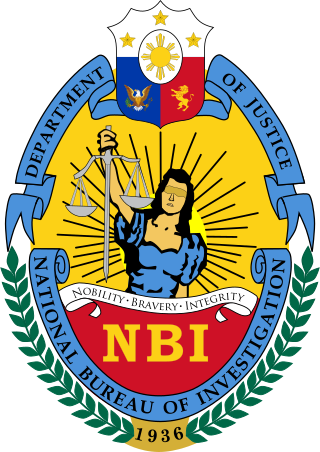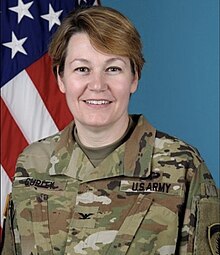
Article Two of the United States Constitution establishes the executive branch of the federal government, which carries out and enforces federal laws. Article Two vests the power of the executive branch in the office of the president of the United States, lays out the procedures for electing and removing the president, and establishes the president's powers and responsibilities.

The United States Marshals Service (USMS) is a federal law enforcement agency in the United States. The USMS is a bureau within the U.S. Department of Justice, operating under the direction of the attorney general, but serves as the enforcement arm of the United States federal courts to ensure the effective operation of the judiciary and integrity of the Constitution. It is the oldest U.S. federal law enforcement agency, created by the Judiciary Act of 1789 during the presidency of George Washington as the "Office of the United States Marshal". The USMS as it stands today was established in 1969 to provide guidance and assistance to U.S. Marshals throughout the federal judicial districts.
Marshal is a term used in several official titles in various branches of society. As marshals became trusted members of the courts of Medieval Europe, the title grew in reputation. During the last few centuries, it has been used for elevated offices, such as in military rank and civilian law enforcement.

The Supreme Court is the highest court in the Philippines. The Supreme Court was established by the Second Philippine Commission on June 11, 1901 through the enactment of its Act No. 136, an Act which abolished the Real Audiencia de Manila, the predecessor of the Supreme Court.

The National Bureau of Investigation is an agency of the Philippine government under the Department of Justice, responsible for handling and solving major high-profile cases that are in the interest of the nation.
The enumerated powers of the United States Congress are the powers granted to the federal government of the United States by the United States Constitution. Most of these powers are listed in Article I, Section 8.
Oyez is a traditional interjection said two or three times in succession to introduce the opening of a court of law. The interjection is also traditionally used by town criers to attract the attention of the public to public proclamations.

The government of the U.S. State of Oklahoma, established by the Oklahoma Constitution, is a republican democracy modeled after the federal government of the United States. The state government has three branches: the executive, legislative, and judicial. Through a system of separation of powers or "checks and balances," each of these branches has some authority to act on its own, some authority to regulate the other two branches, and has some of its own authority, in turn, regulated by the other branches.
Pamela T. Talkin is a former Marshal of the United States Supreme Court and the first woman to hold this position.
Agostini v. Felton, 521 U.S. 203 (1997), is a landmark decision of the Supreme Court of the United States. In this case, the Court overruled its decision in Aguilar v. Felton (1985), now finding that it was not a violation of the Establishment Clause of the First Amendment for a state-sponsored education initiative to allow public school teachers to instruct at religious schools, so long as the material was secular and neutral in nature and no "excessive entanglement" between government and religion was apparent. This case is noteworthy in a broader sense as a sign of evolving judicial standards surrounding the First Amendment, and the changes that have occurred in modern Establishment Clause jurisprudence.

In the United States, a sheriff is an important official of a shire or county charged primarily with judicial duties. In the United States, a sheriff is one of the chief administrative offices in the country. It is his duty to take charge of prisoners, to oversee juries, and to prevent breaches of the peace. Sheriffs are usually elected, although some states have laws requiring certain qualifications of candidates. Elected sheriffs are accountable directly to the citizens of their county, the constitution of their state, and ultimately the United States Constitution.
The Government of Guam (GovGuam) is a presidential representative democratic system, whereby the president is the head of state and the governor is head of government, and of a multi-party system. Guam is an organized, unincorporated territory of the United States with policy relations between Guam and the US under the jurisdiction of the Office of Insular Affairs.
The Chief Justice of the Democratic Socialist Republic of Sri Lanka is the head of the judiciary of Sri Lanka and the Supreme Court of Sri Lanka. Established in 1801, the Chief Justice is one of ten Supreme Court justices; the other nine are the Puisne Justices of the Supreme Court of Sri Lanka. The post was created in 1801. The Chief Justice is nominated by the Constitutional Council, and appointed by the President. The first Chief Justice was Codrington Edmund Carrington. The 47th and current Chief Justice is Jayantha Jayasuriya.

The Office of the Solicitor General of the Philippines, formerly known as the Bureau of Justice, is an independent and autonomous office attached to the Department of Justice. The OSG is headed by Menardo Guevarra.
The County sheriff (Florida) is a Florida constitutional officer and a part of the state judicial branch.
Schlesinger v. Reservists Committee to Stop the War, 418 U.S. 208 (1974), was a decision by the United States Supreme Court which ruled that citizens do not have the right to challenge the constitutionality of members of Congress holding reserve commissions in the armed forces.
The Philippine Truth Commission was created to find out the truth about reports of large scale graft and corruption in the previous government; to put a closure to them by the filing of the appropriate cases against those who were involved. Furthermore, to deter others from committing such crimes and to restore the people's faith and confidence in the government and in their public servants. On July 30, 2010, President Benigno Aquino III set up the Philippine Truth Commission to find out the truth about reports of large scale graft and corruption in the previous government and to put a closure to them by the filing of the appropriate cases against those who were involved. Furthermore, to prevent others from committing such crimes and to restore the people's faith and confidence in the government and in their public servants.
An officer of the United States is a functionary of the executive or judicial branches of the federal government of the United States to whom is delegated some part of the country's sovereign power. The term "officer of the United States" is not a title, but a term of classification for a certain type of official.
In the United States, there is no consistent use of the office of constable throughout the states; use may vary within a state. A constable may be an official responsible for service of process: such as summonses and subpoenas for people to appear in court in criminal and/or civil matters. They can also be fully empowered law enforcement officers. Constables may have additional specialized duties unique to the office. In some states the constable is an elected or appointed position at the state or local level of local government. Their jurisdiction can vary from statewide to county/parish and local township boundaries based on the state's laws.

Gail Anne Curley is the 11th Marshal of the United States Supreme Court, serving since June 21, 2021. Before beginning her term as Marshal, she served as a staff judge advocate (attorney) in the United States Army.









